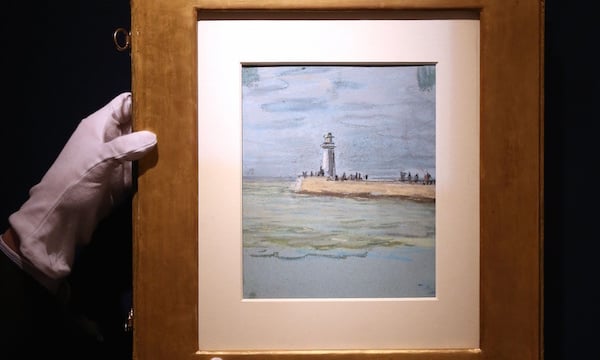
Photo: Philip Toscano
Jonathan Green, director of London’s Richard Green Gallery, hit the proverbial dealer’s jackpot when he unwittingly purchased three pastels by Claude Monet at a Parisian auction in 2014 for the price of two.
After returning home, Green noticed that there was something fastened to the back of one of the two rare studies of skies that he had bought for an undisclosed sum—it turned out to be another pastel which depicts a jetty and a lighthouse at Le Havre in Normandy, where the legendary artist grew up.
The paper conservator Jane McCausland was hired to remove the tape, which revealed the secret Monet pastel. “We were very excited,” Green told the Guardian. “Pastels by him are incredibly rare. These are a pointer to his future … You can see his fascination with light.”
Moreover, the provenance of the three pastels is phenomenal—it links back directly to the artist, as all are thought to date to 1868, when Monet was still a struggling artist.
The pastels by Claude Monet bought by dealer Jonathan Green at auction
Photo via: Richard Green gallery
The pastels by Claude Monet are currently for sale at the London art fair Masterpiece
Photo via: Richard Green gallery
They were Monet’s wedding present in 1924 to Anne-Marie Durand-Ruel, the granddaughter of his dealer Paul Durand-Ruel, the first modern art dealer and Impressionist champion, and most recently the subject of a major exhibition at London’s National Gallery.
Starting today, all three rare pastels are on display and up for sale at the London art and antiquities fair Masterpiece, for a combined total of £1.4 million ($2.2 million).
This is a momentous event, since, according to the gallery, the pastels have not been exhibited since 1928 and the 2014 auction marked their very first outing in the art market, as they had remained within the Durand-Ruel family until then.
“It’s very unusual to have three Monet pastels,” Susan Morris, senior researcher at Richard Green gallery, told the Guardian. “They really don’t come up that much. It’s also exciting to have it from Durand-Ruel, the man who created Monet’s career.”
Photograph of Paul Durand-Ruel in his gallery, taken by Dornac, about 1910
Photo: Archives Durand-Ruel
Finding pieces taped to the back of works, or hidden in frames is a far more usual occurrence than it might seem at first. Last February, the Barnes Foundation in Philadelphia discovered two previously unknown sketches by Paul Cézanne on the backs of two important watercolors that hang in the galleries of the foundation.